Love will tear us apart

Photo by Kimberley French. Courtesy of MUBI.
DP Seamus McGarvey BSC ASC ISC harnessed KODAK 35mm EKTACHROME to compose Lynne Ramsay's acclaimed and colorfully bleak comedy-drama, Die My Love, and declares, "It's some of the best work I've ever done."
The slow-burn film follows Grace and Jackson, a young couple who relocate from New York to Jackson's childhood home in rural Montana, in search of a quieter life. At first, they are deliriously happy together, engaging in passionate sex and drinking cold beer to offset the oppressive summer heat.
However, as they adjust to their new surroundings and soon become parents, Grace starts to struggle with feelings of isolation and psychological distress about marriage, motherhood and domesticity. Despite help from family and friends, her deteriorating mental health gradually drives their marriage into dangerously unpredictable territory, where reality and fantasy become blurred.
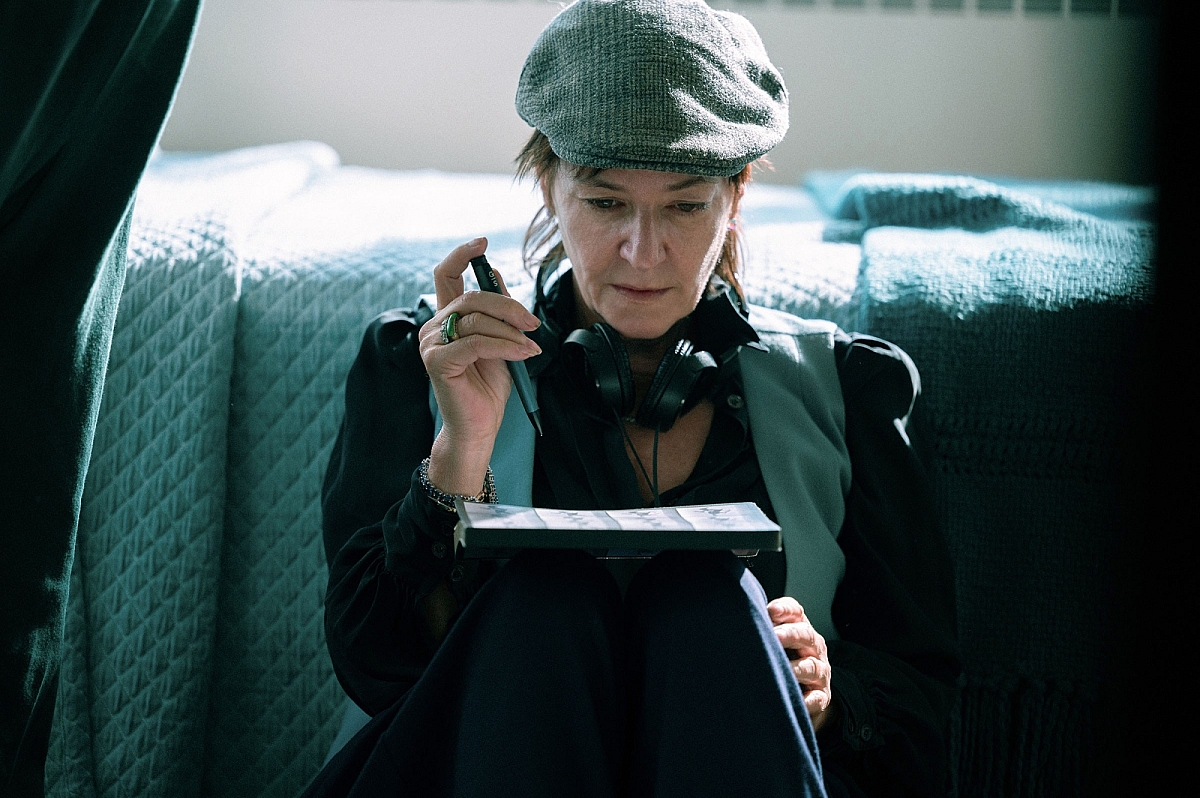
Director Lynne Ramsay during production of "Die My Love." Photo by Kimberley French. Courtesy of MUBI.
The film, starring Jennifer Lawrence and Robert Pattinson, alongside Sissy Spacek, Nick Nolte and LaKeith Stanfield, is based on the 2012 novel Die, My Love by Argentine writer Ariana Harwicz. It premiered in-competition at the 2025 Cannes Film Festival, where it received a six-minute standing ovation and earned critical acclaim for the abilities of the cast and filmmaking team to emotionally-connect the audience to themes about identity, happiness, postpartum depression and mental health.
Die My Love is the second collaboration between Ramsay and McGarvey following We Need to Talk About Kevin (2011), which McGarvey also captured on KODAK 35mm film.
"I've known Lynne since she was at film school, and we've been great friends ever since," McGarvey enthuses. "She's such a vivid person, and it's always exciting to work with her because she has such a natural understanding of how to use the camera to weave the narrative thread. She's very good at finding frames and spaces between lines of dialogue that can say just as much as the words themselves.
"What attracted me to this film was the honesty in how the script dealt with big, serious issues that affect a great many people. I also loved Lynne's deft touch in being able to use comedic moments to both prick and intensify the darkness. She doesn't have hard-and-fast rules about filmmaking and is open to ideas, and she has an intimate relationship with music and sound as part of the storytelling. This liberates your thinking about how you portray cinematographically what's on the written page."
He adds, "When all of that was coupled to working with actors of the caliber of Jennifer, Robert, Sissy, Nick and LaKeith, in a real rural location that helped to focus everyone's attentions, I just thought, 'Wow, what a toybox!'"
Some creative references came in the form of well-known artworks, such as Christina's World (1948) by American painter Andrew Wyeth, for its evocative rural environment, especially what McGarvey calls "the quivering nature of the prairie grasses and its back-of-the-head composition," delivering a sense of emotional separation, vulnerability and the unknown world of inner thoughts.
Further inspiration came from the French post-Impressionist Henri Rousseau for the overwhelming presence of nature in his paintings, and the bountiful but sometimes violent dream spaces where humans and animals coexist.

DP Seamus McGarvey on set during production on "Die My Love." Photo by Kimberley French. Courtesy of MUBI.
For the film's nighttime sequences, McGarvey considered paintings that gave a sense of dreamscapes and perpetual twilight, such as the atmospheric cyanotype Nocturnes of photographer Edward Steichen, and various works by the Belgian surrealist René Magritte and the Italian metaphysical artist Giorgio de Chirico. Indeed, given the movie's fairly tight budget, and the volume of nighttime outdoor scenes to contemplate, these references led the DP to shooting day-for-night, thereby imbuing the images with what he calls "a mysterious, psychic stylisation".
Cinematic references encompassed the filmmaking style of Douglas Sirk, in films such as All That Heaven Allows (1955, DP Russell Metty ASC), where doorways, windows and reflections are used to frame characters in the stifling constraints of domestic spaces, and Rosemary's Baby (1968, dir. Roman Polanski, DP William A Fraker ASC) for its creation of psychological tension. McGarvey also notes the experimental silent short Meshes of the Afternoon (1943, dirs. Maya Deren & Alexander Hackenschmied, DP Alexandr Hackenschmied) that explores subjective experiences and the subconscious through surreal and symbolic imagery, including a knife.
"Essentially, we were inspired by a kaleidoscope of disrupted, broken images where you can't quite grasp onto the surety of a regular portrait or setting. We wanted this film to be alluring at times, unsettling at others. Passionate then oddly dangerous, and even animalistic."
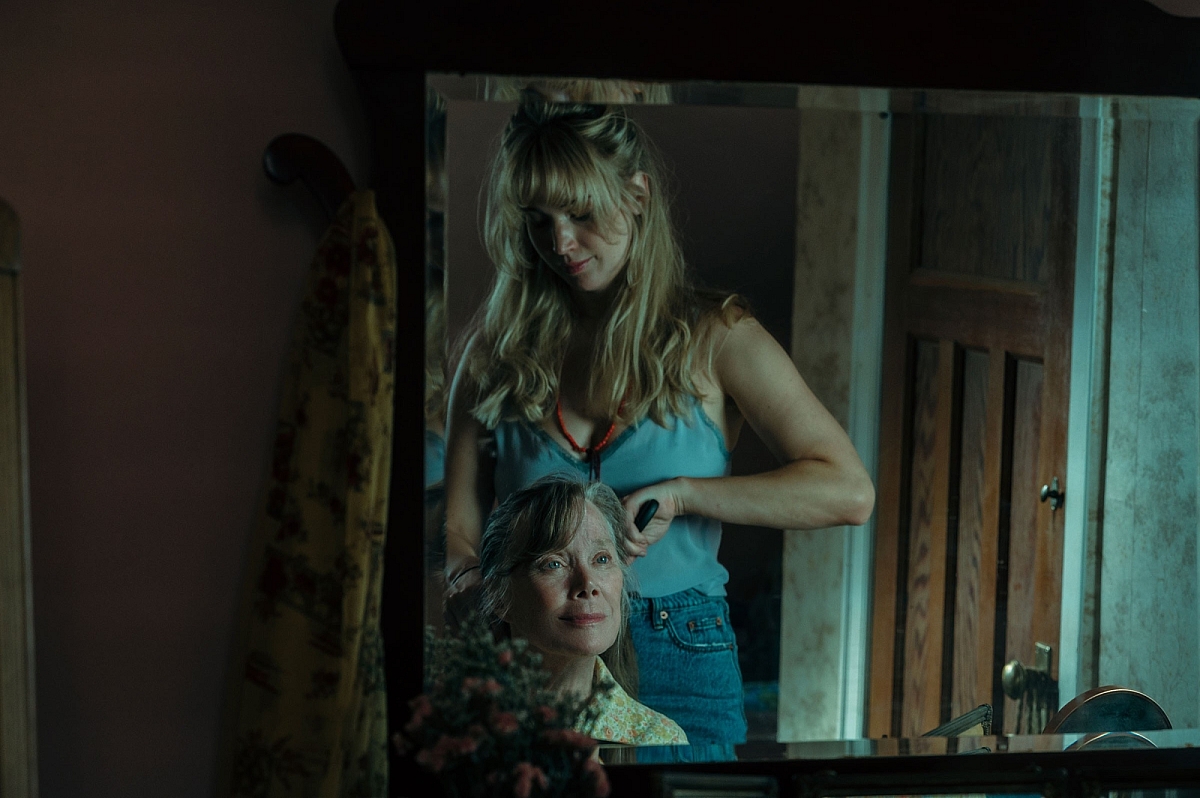
Photo by Kimberley French. Courtesy of MUBI.
McGarvey says there was never any doubt that Die My Love would be shot on analog film, adding, "It's an act of faith. You have to allow yourself to fall into the intangible mystery of the filmic process from the camera to the lab, where happenstance is often registered in happy accidents. Film gives an impression rather than a factual digital binary recording of something, and quite often the results make your hairs stand on end.
"On a practical level, Lynne tends to shoot very few takes. She's very decisive about her shots and knows when she has what she wants. So, I knew we would shoot less, and weren't going to break the bank."
Explaining how he and Ramsay arrived at using KODAK EKTACHROME Film, McGarvey relates, "We wanted to capture real scenarios, but to render them in an otherworldly, almost spectral, way. We considered shooting infrared, but after I tested EKTACHROME we knew we had the stock we needed to create a dreamlike and phantasmagorical feeling to the imagery.
"EKTACHROME is imbued with its own peculiar photographic properties – striking colors but accurate flesh reproduction, a certain sharpness and fine grain, high contrast and reduced latitude, just six stops. It's a limiting palette that is difficult to shoot with because there's no forgiveness, there's no leeway. Any over or under-exposure gets baked-in to the film and there's no going back from that. You have to live with the decisions you make on-set, but the outcome is always special."
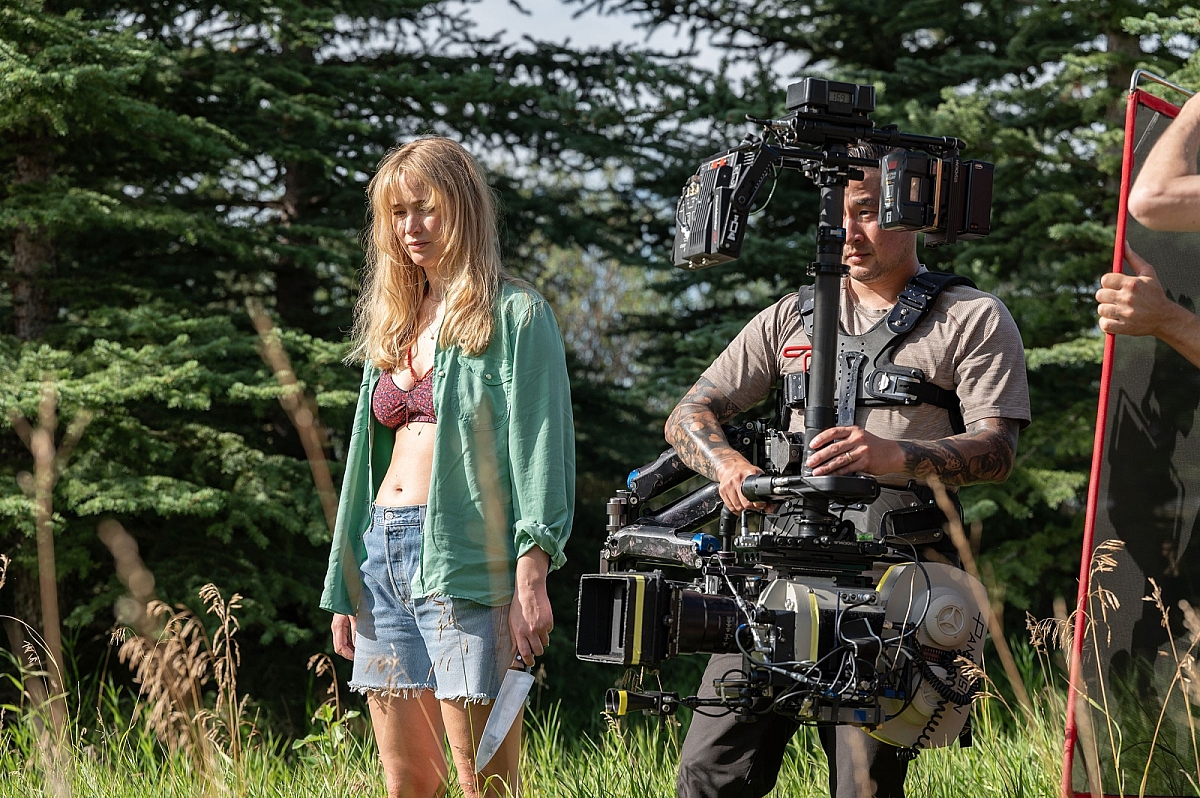
BTS photo of Jennifer Lawrence as Grace, being filmed by camera operator Chris Chow, on "Die My Love." Photo by Kimberley French. Courtesy of MUBI.
Production on Die My Love took place over 29 shooting days between August and October 2024, at locations in and around Calgary, Canada, with some work filmed on interior sets constructed in the ballroom of a hotel, and car scenes shot against an L-shaped LED wall, measuring some 12 x 12ft.
McGarvey framed the film in Academy 1.33:1 aspect ratio, predominantly using Panavision Millennium XL 35mm cameras, plus an ARRLIFLEX IIC for handheld work. His lenses included P-Vintage glass, a brace of Petzval optics in 58mm and 85mm focal lengths, and a Canon T0.95 Dream Lens. He also used a variety of Tiffen Glimmer and Black Glimmer Glass filtration to enhance the filmic aura in the picture. The camera and lens package was provided by Panavision in Calgary, except for the Petzvals and Canon lenses, which McGarvey co-owns with filmmaking friends.
"We wanted to shoot in Academy ratio from the outset because, although we'd be including landscapes and rural vistas, the core of this film was a portrait of a woman, with very few group shots.
"Although I have never shot in Academy aspect ratio before, I loved how it was used in recent features like Ida (2013, dir. DPs Paweł Pawilkowski, DPs Łukasz Żal PSC & Ryszard Lenczewski) and Saltburn (2023, dir. Emerald Fennell, DP Linus Sandgren FSF ASC). There's a claustrophobic imprisonment to the frame that lets you get inside someone's head.
"On interior wides, you see more of the ceiling than you would do in 1.85:1 or 2.35:1, and we embraced the idea of framing shots with additional headroom. As for landscapes, you can use this aspect ratio to recognize the insignificance of humans, which we also really liked."
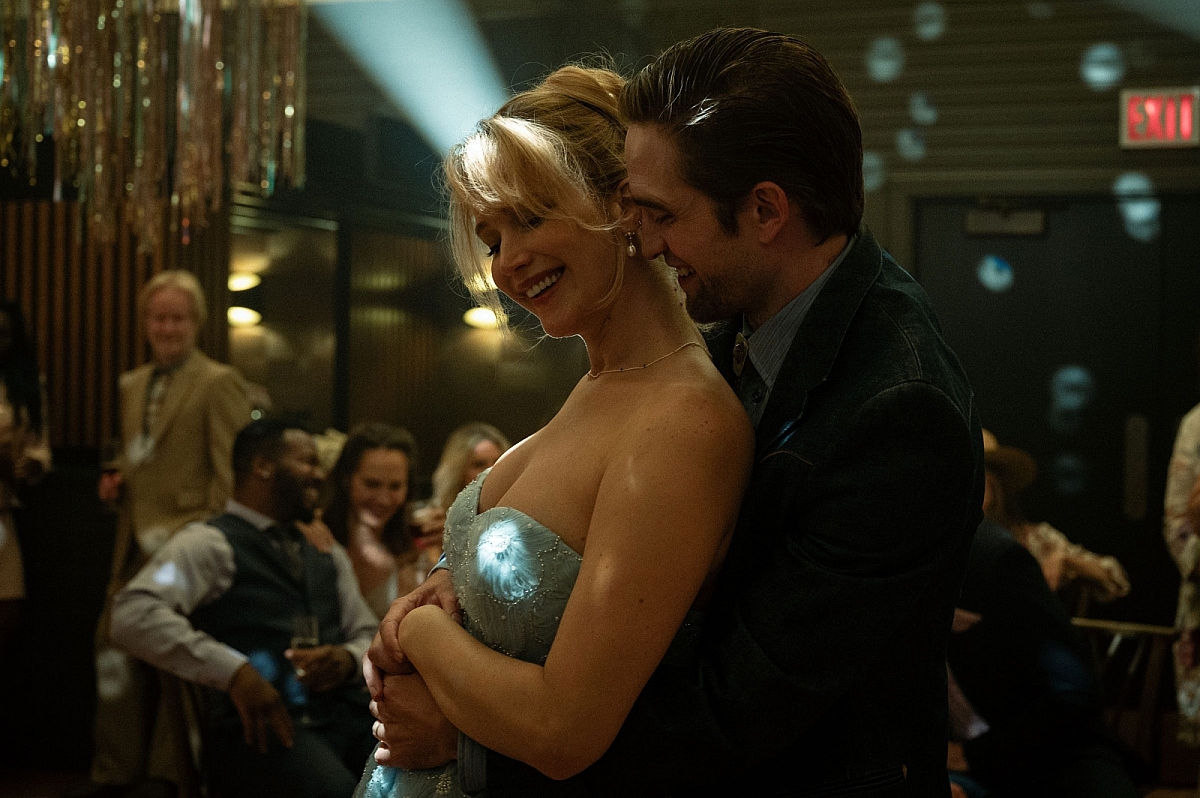
Photo by Kimberley French. Courtesy of MUBI.
Speaking about his lens selection, McGarvey says, "The PVintage lenses incorporate vintage glass from Ultra Speed primes and give a lovely organic and dreamy look. Generally speaking, I used the Petzvals on the exterior close-ups of Jennifer as they have a beautiful swirling bokeh, akin to the look we liked in Christina's World, a kind of dizziness that helped us get inside her head. The Canon Dream Lens brought subtle vignetting when used wide open and gave the image a charming glow."
McGarvey estimates he shot two thirds of the movie using KODAK EKTACHROME 35mm Color Reversal 5294 Film, mainly daytime exterior/interior scenes due to its 100ASA rating, switching to KODAK VISION3 5213 200T and KODAK VISION3 5219 500T negative stocks for darker scenarios and day-for-night sequences.
"For the night photography, particularly the exterior day-for-nights, we were inspired by Steichen's cyanotypes, where the images have a monochromatic wash of cyan. I could have filmed the day-for night scenes on EKTACHROME but, because of its limited latitude, the results would have looked too lithographic and crunchy. So I shot those using the 200T and 500T.
"We didn't want a typically cinematic cool, backlit nighttime look that comes with shooting day-for-night, but something more nightmarish, rather a remembered nightmare or kind of a fever dream.
"However, one of the difficulties I faced was that the skies were bright-white and burnt-out. To mitigate that, I made candle-smoke filters from optical flats, which I blackened slightly with smoke from a candle flame, before rubbing-away the areas that I did not want to affect the image. This left a smoky band that would cover the sky, and the look was baked-in to the image. It was very effective, and when you think you see the moon, it was actually the sun. I also used the candle smoke filters on some of the day exteriors for atmospheric effect.
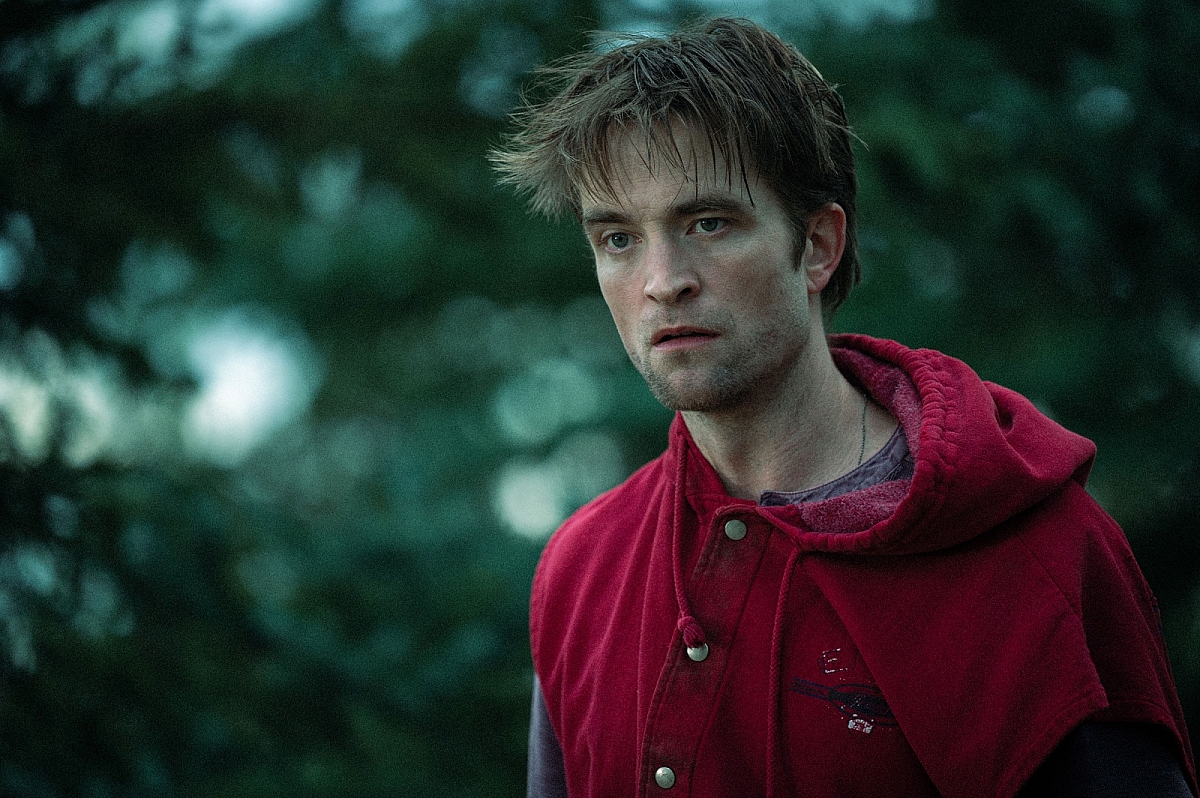
Photo by Kimberley French. Courtesy of MUBI.
"I got some comments about those pictures looking weird, but Lynne is such a renegade and thought it was fantastic, an almost hand-knitted quality. With some VFX help during post we dotted some slightly out-of-focus stars, and the results looked spectral and phantasmagorical."
Film processing and 4K scanning were done at Cinelab in the UK with the dailies supervised by dailies colorist Darren Rae. "Before we shot, I did a lot of testing, and Darren understood the concept of what we were going for right away, which consequently meant that the dailies had beautiful coloring with the shadows opening up for a softer look."
Die My Love was a single-camera shoot in the main, with Chris Chow working as the camera operator, frequently working handheld, assisted by Cory Budney on focus. Gary Winter led the grip team, with Martin Keough working as gaffer.
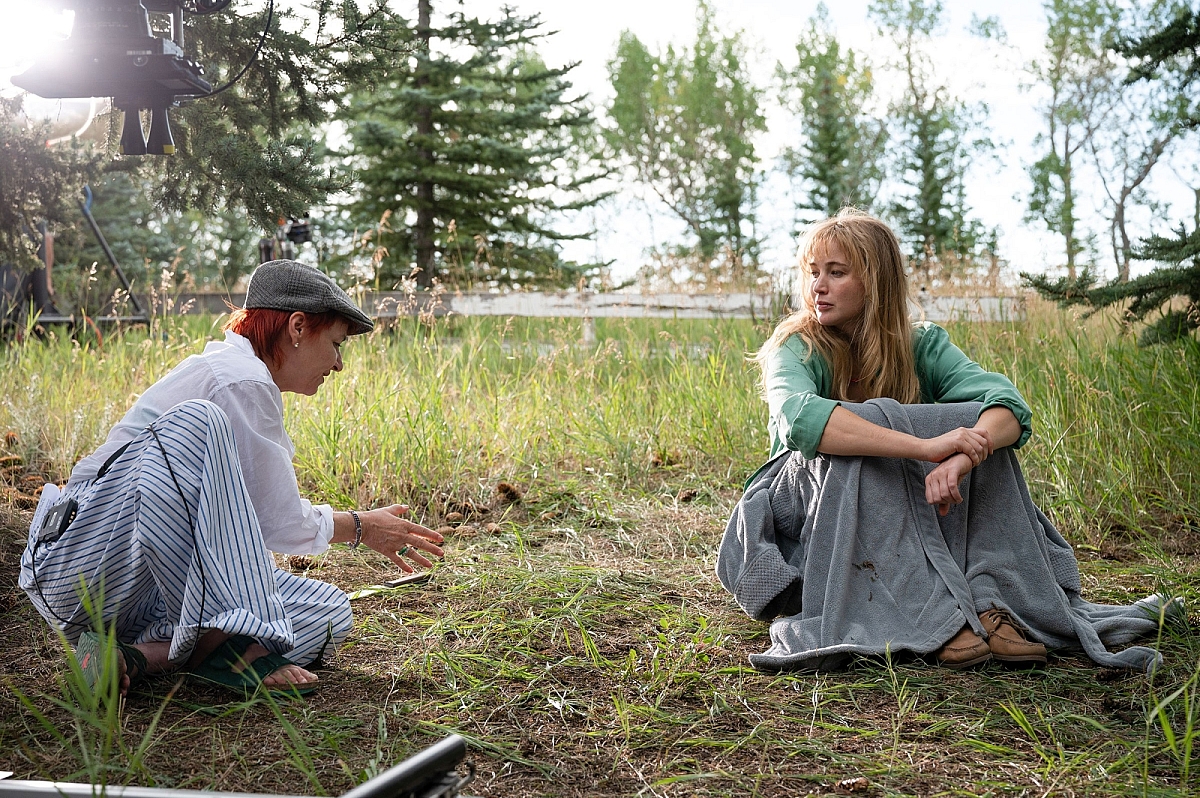
Director Lynne Ramsay with Jennifer Lawrence during production on "Die My Love." Photo by Kimberley French. Courtesy of MUBI.
"Chris is a brilliant operator, and did an extraordinary job," McGarvey notes. "We didn't want rectitude or rectilinearity in the framing or camera movement, rather that the images had a sense of being slightly skewed, of things being not quite right. So handheld became a key component of the photographic style.
"A lot of the time we wanted to let the performances run and you've got to be alive photographically enough to capture it. Often when you give actors the limits of framing, it can be very asphyxiating for them in terms of their movement. So handheld allowed for a kind of free-range choreography with the performers.
"In the meadow scenes, of Grace and Jackson prowling around on all-fours in the long grass, I remember Lynne talking about the images being accompanied by the sound of insects, and the place being alive with the noises of crickets and bugs.
"So I suggested keeping the camera almost on the ground, as close as possible to the actors and inside the soundscape she had described to me. Chris filmed those shots on EKTACHROME using a Petzval lens, which made the background swirl like crazy. The results really spoke to our original idea of the film being passionate, oddly dangerous and animalistic."
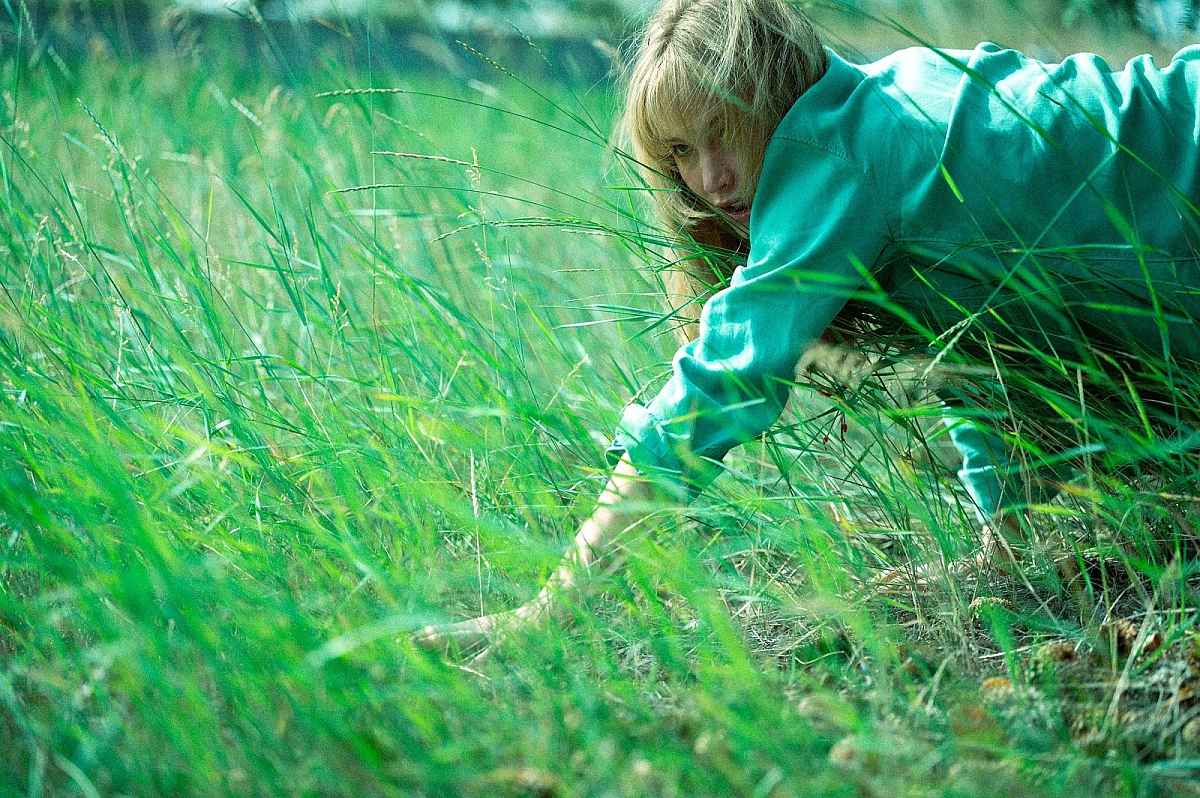
Photo by Kimberley French. Courtesy of MUBI.
Regarding the car work and shooting using LED walls, McGarvey says, "The best and the worst conversations often happen in cars, and when you've got a performance to consider, it's often a pain in the ass shooting with a process-trailer or low-loader.
"The thinking was to create a sense of the car being a pressure-cooker, and to enable the actors to easily run and re-run their performances, rather than waste time resetting the car at the end of a road between takes and going again.
"That's how we arrived at using an LED wall. We shot high-rez background plate footage using a small Blackmagic camera array. Using a turntable to spin the car round whilst also reversing direction of the background footage, we were able to shoot all of our car work in a day, again using the EKTACHROME. When we got the rushes back, I found the wall itself gave out a strong magenta cast, but that was quickly fixed during the DI by our colorist Adam Inglis at Harbor."
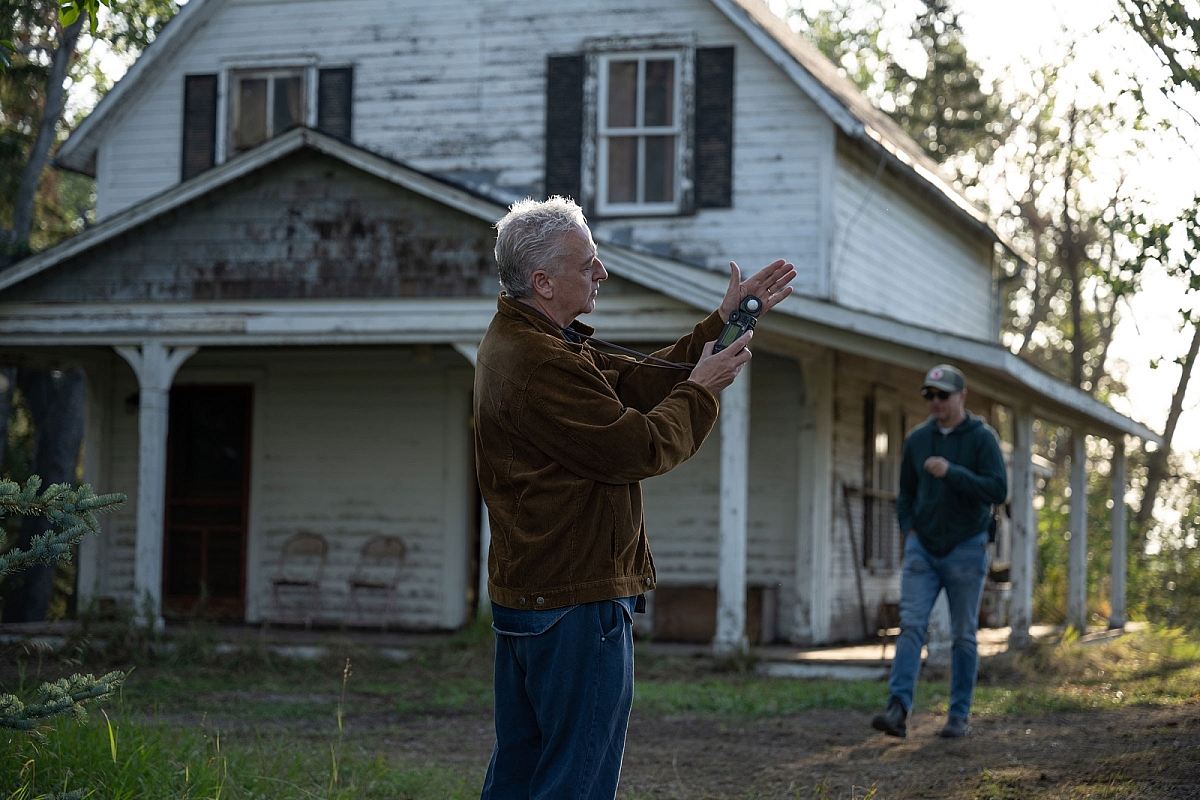
DP Seamus McGarvey metering the light during production on "Die My Love." Photo by Kimberley French. Courtesy of MUBI.
McGarvey says his approach to the lighting was based on the space and architecture of the location, and the actors' movements.
"Because of the sensitivity of digital cameras, there's a temptation and a tendency to shoot without much light, which I find gives the image a disappointing murkiness. With the EKTACHROME particularly, I enjoyed throwing-in light that had direction and meaning, and was happy to mix traditional sources like HMIs with LEDs.
"On the interiors, I mainly bounced light-in from the outside, and depending on how that rebounded around a room on objects and faces, might subtly supplement the interiors with ARRI Sky Panel S60s, LiteGear Lite Mats and Astera tubes, plus Astera Luna Bulbs in the practicals. At other times, on the day exteriors, it was sometimes as simple as following the actors about with a bounce board.
McGarvey concludes, "It may have been the nature of the story, but this was actually quite a difficult film to shoot for all sorts of reasons, including a certain tension at times. But I think it's one of the best films I've ever made in the how the photography was psychologically in-tune with the story, and I'm very proud of how it has been received."